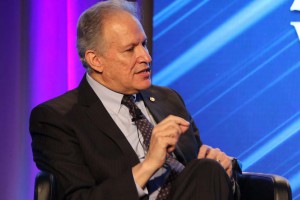Transportation Secretary Anthony Fox is planning to announce what is being described by his office as “new actions on vehicle automation,” though a senior member of his department has also hinted that it will be part of a “potentially history-making” series of steps in terms of improving highway safety.
With the support of both the auto industry, as well as many state and regional regulators, Fox is expected to announce that the Department of Transportation will take steps to make it easier for the industry to develop, test and eventually bring to market a new generation of semi- and fully autonomous vehicles. The ultimate goal is to sharply reduce the number of deaths on U.S. highways.
It’s one of three announcements set to come from Washington in a matter of weeks designed to spur innovation and improve safety, Mark Rosekind, the head of the National Highway Traffic Safety Administration, said this week, noting that, “These actions going forward (will) change the nature of the auto industry.”
That is due, in part, to a change in thinking both in Washington and in the industry. There is a growing recognition that safety must be the priority element in automotive planning. And that will take a more cooperative approach, not only between industry and regulators but among manufacturers, as well.
“We need to get to the stage where safety is no longer a competitive tool,” but something all manufacturers are expected to deliver, Fiat Chrysler CEO Sergio Marchionne said this week at the North American International Auto Show in Detroit.
(For more on the upcoming announcements. Click Here.)
The initiatives planned by the Department of Transportation will start with efforts to ease the way for developing self-driving vehicles. Currently, the technology faces a series of regulatory obstacles, industry officials have complained. They also are looking for some level of government cover that will reduce the potential legal liabilities they face developing hands-off technology.
While the DoT has not signaled what sort of changes are in store, it may also take steps to expand the geographic range where prototype autonomous vehicles may be tested. Currently, only a handful of states – notably including Nevada, Florida, California and Michigan – have actually put specific rules in place.
On Tuesday, Google autonomous vehicle chief John Krafcik noted the need to run his company’s test fleet in a broader range of geographic and weather conditions.
(Industry trade group toughens safety test standards. Click Here for the story.)
Virtually every major automaker currently has launched an autonomous vehicle program, as have key suppliers and some non-automotive technology firms, such as Google. Tech firm Apple is also believed to be setting up a program to build autonomous electric vehicles.
Sec. Fox’s Thursday announcement is just the first significant development Washington will participate in. A second may come as early as Friday if transportation officials can lock down plans with 16 automakers who aim to become part of a new industry-government safety consortium. The goal will be to work together on new safety initiatives and bring those developments to market faster than might happen if regulations were required.
Several details have yet to be worked out, cautioned some of the potential participants in the consortium, including both Ford and Honda. Other members are expected to include General Motors, Fiat Chrysler, Daimler, BMW, Toyota, Nissan and Hyundai.
A third announcement that could come this month, according to NHTSA’s Rosekind, would follow up on the formation of another industry consortium last September. At that time, 10 makers agreed to jointly work up plans to make automatic emergency braking standard on all their vehicles, from high-end luxury models to the most basic, entry-level offerings.
Automatic emergency braking can detect a potential collision and, if a motorist doesn’t respond to a warning, such a system will automatically apply a vehicle’s brakes to avoid the crash or at least reduce the risk of death and injury.
NHTSA has now set a goal of reaching the point where there will be no deaths on U.S. roads. Several automakers, including Nissan and Volvo, have set similar targets. That’s a significant stretch considering 32,000 Americans were killed in crashes in 2014, though the number is down about 40% from the peaks set in the 1970s.
Worldwide, an estimated 1.25 million people were killed in vehicle crashes in 2014, the most recent year for which data is available.
(Toyota working on breakthrough that could vastly increase the flow of data to vehicles. Click Here to find out how.)




Instead of the Feds properly doing their jobs and establishing mandatory safety, security, design, manufacture and maintenance on AVs, the criminals in DC are more concerned with throwing money at their crony Biz friends while abdicating their responsibility to make AVs safe and secure. The delusional belief in DC and elsewhere is that AV’s will eliminate all vehicular fatalities when this belief is simply a fantasy. Wait until the first AVs start killing people and then the media will wake up and demand answers.
It’s completely unacceptable for the Feds to not have already established the mandatory AV safety and security requirements. The legal community also needs to define liability and agree on who will die in unavoidable accidents. AVs have the potential to help many in society but not with a rush to market mentality, as the Google car statistics prove.